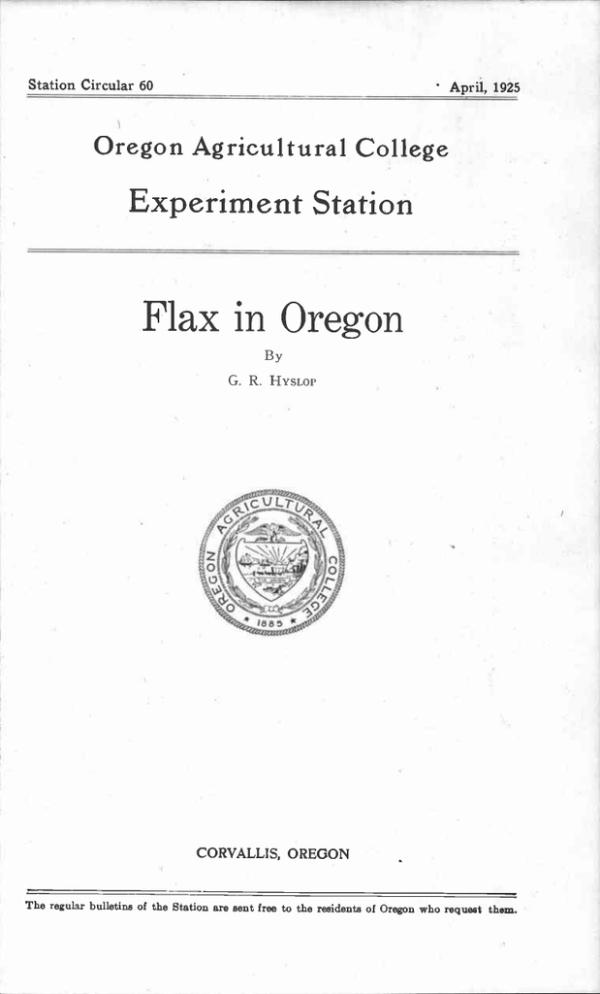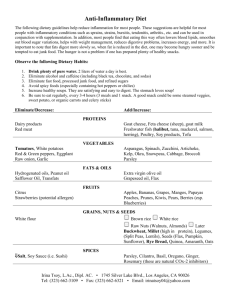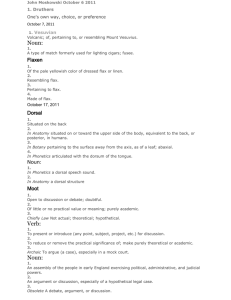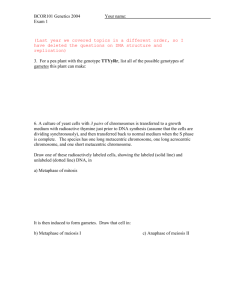Flax in Oregon Experiment Station Oregon Agricultural College Station Circular 60
advertisement

Station Circular 60 April, 1925 Oregon Agricultural College Experiment Station Flax in Oregon CORVALLIS, OREGON The regular bulletins of the Station are 8ent free to the residents of Oregon who request thorn. BOARD OF REGENTS OF THE OREGON AGRICULTURAL COLLEGE AND EXPERIMENT STATION HON. HON. HON. HON. HON. HON. HON. HON. HON. HON. HON. HON. HON. 3. K. \VEATILER;oito. President JEFFERSON MYERS, Secrctary......._.._ ......___ U. F. lavisa, Treasurer....WALTER 1W. PIERcE, Govcrnor - Portland .................- .Portland _................_.._ salem Salem SAM A. KOZER, Secretary of State..._........- ....r J. A. CHORCIiiI.i., Superintendent of Public lnstruction....----......... GEoRGE A. PAX.MctEn, Master of State Grange............__...... __-._..-Hood River Pendleton E. B. Aisaicn......._ Gervais ....._ ........- ........SAN H. BROWN Lalcevicw HARRY BAILEY...................... Portland CEO. M C0RNWALI Astoria Mt W. S. KINNEY ........... ....... Corvallis K E. Wr,soe .._........_.._ STATION STAFF President .._._.........Director J. 'I. JARDINE, lJ.S._..........Editor ... ......... E.T.RaEo,11.S.,A.B ..........._.........._...._.._PInt Pathologist _ H. P. l%ARss, LB.. S.M B. B. DAlLaS...............__Juaior Agronomist. Office of Ccr. inves., U. S. Dept. of Attn. _.......Dairy Husbandman P. H. Buasar, 13.5., AS ..-.-...-Horticulturist (Vegetable Gardening) ...........A. U. BouQuEt, 13.8 ..Associate Agronomist E. N. BnEsMAfl, 13.S........ Br. Exp. Station, Flood River 0. 6. ]3owtc, U.S....._......- Horticulturist, Maccl River in Charge W. S. BROWN, A.13., M.S.....-................... Assistant Chemist ....... ............_.Hortieulturist 0. E. l3uu.is, ]j,S........._..._..._.... Stipt. Hood River Branch .xp. Station, Hood River LEROY CRJLOS, A.B l3acteriologist . G. V. Copsos, M.S.......................----... Supt. Umatifla Branch Lap. Station, Hermiston U. K. Dnw, 13.5 _Asst. Animal Husbandman, East. Ore. Br. Exp. Sta., Union Frovo M. EDWARDS, B.S \V.J.Ksas, D.Sc.,LL.l)....................._....- ....__ - --- A. E. Esougstrsos, U.S..............Supt. John Jacob Astor Dr. Exp. Station, Astoria L. N. G000niric, HA., ILS................_....._....-......Jr. Plant Pathologist, U. S. Dept. of Agri. Associate I3actcriologtst - ......_...._...... \V. V. HavEltsEzi Ph 0.. Associate Horticulturist (Pomology) I-i. Hsjstaas, M.S.._ ....... Horticulturist (Physiology) IL. 1W. HARVEY, Ph.D......._... Scientific Assistant Seed Lab., U. S. Dept. of Agri. (Seed Analyst) I3ERTSIA M. lie-ta. RAYMOND HoRtou....... -----__......Asst., to 5us$. of Harnçy Co: Branch Ixp. Station, Burns MaRY HuMFELD, B.S._.............Assistant to Supt. off tJmatilla Br. Lap. Sta., Hermiston C. R. HysLop, B.S............................... W. W. JOHNSTON, B.S..,........._.__.......___.. J. S. JONES, M.S._ Ft. C. JONES. J3.S. F. ........ ......gronomlst _... ....__-.-_ .Assustant in Soils (Irrigation) ..._._._ _._...._ .......... ..............-. .....Assoc,ate Dairy Husbandman I.. KNOWLTON, 11.5....... .......,....... .,,... J. C. Law-is Ä. C,. LUIcN, B.S M. 13. McKAY, M.S.___.___._..._... F. . MIt.LER, M.S., D.V.M H. &.. MILLER, l'h.D._...__...._...._... Assistant Poultry Htisbandman Farm Crops Foreman .....roultry Hushandman in Charge Plant Pathologist ...Associate Veterinarian _.._.... ............. .................chemist C.. A. MITCHELL, l3.S..........Asst. to Supt. ofSherman County Branch E'tp. Station, Moro DoN C. MOTE, M.S............................. 0. 1W. NELSoN, lbS .._.....Entomologist --.-.-.---. ..-Animal Husbandman R. K. N0anrs, ll.S._..Assistant to Supt of Southern Oregon Branch Lap. Station, 'latent ...Assistant .knii,ial Flusbandn,an A. W. OLivzg, lLb,._......._. _.._Animal Husband,naii It. L. POTTER, M.S ....._...._ Chief, Department of Soils L. POVERS, M.S . F. C. REntER, M.S..............-_ Supt. SUuthern Oregon Br. Exp. Station. Talent Chemist R. H. Roiitrssos, M.S..-.. Assistant Agronomist C. C. Runt, M.S Associate in Soils (Fertility) C. V. ItuzEic, U.S................- ............. H. A. Scitoru, M.S.....Asst. Agronomist, Forage Crops investigation. U. S. Dept. of Agri. C. S. Sc,rusrscg, M.S._........._ ._.._..Associate Horticulturist (Pornology) H. I). Scvi,ogu, II),-----... Chief ni Farm Management 0. Sicnuci, MS..... .......Supt.. Harney Valley Branch Exp. Station, Burns Veterinanaa 0. 1. Sigs, D.V.M 0. E. STEPhENs, OS _.Supt. Sherman County Br. Lap. Station, Moro _...-..........-....Assistant Soils Specialist k. STEPIIEXSON Pli.D._._ .........._. 8. (i. lJLOMi'SON, B.S.... Assistant Entomologist h. F. IOItCERSON, B.S..................._..._._._._._._.Sssistant in Soils (Soil Survey) H. N. Wanwpaucjii, 14.S......Asst. Farm Crops Specialist. East. Ore. Br. Exp. Sta., Union .._.._.............._........_..._.11ortjculturist (Horticultural Products) E. H. \VIEGANO, ZLS... Rout. WITIiYCOMIIE, l$.S................................Supt. Eastern (ire. Branch Lap. Station, Union WILLARD V. \ AttS, 11.5 _.._......Ass,stant Chemist 1W. ZEI.LER, Ph.fl..........._........_.._.._........... ....... .-_._......_._Planu Pathologist Flax in Oregon By G. R. HYSLOP Flax has been grown in Oregon since 1849. Interest in the crop for fiber or seed purposes or both has on several occasions been 'very intense. At no previous time in the writer's experience in the state has there been as much interest in flax. The reasons for this are: (1) An unusual stimulation of interest in fiber flax. (2) A high price for seed flax. (3) An effort on the part of Oregon farmers to balance their farming system and thus produce the things needed for the home market, such as seed flax for oil and fiber flax suitable for manufacture and sale as flax fiber. Trials at the Experin-ient Station and numerous field plantings through a rather long period of years have demonstrated that both seed and fiber flax are successful on many Western Oregon soils. The yield and the quality of the product are good. Types of flax. There are two distinct types of flax, seed flax and fiber flax. They serve entirely different purposes. Seed flax is used almost exclusively in the manufacture of linseed oil and its by-product, oil meal, for stock feed. Fiber flax is grown solely for the production of flax fiber for the spinning industry. It is used in the making of twines, thread, and many kinds of linen goods. The seed of fiber flax, like that of seed flax, may be used in linseed-oil manufacture, to a limited extent in the drug trade, and for seed purposes. The seed production of fiber flax is largely a side line to the major interest, which is the production of fiber. The highest yielding seed varieties are short-strawed, and much branched, carrying many seed bolls and are unfit for fiber production. The finest of the fiber varieties have tall straw, few branches and boils, and produce a large yield of straw with but little seed. The tendency of seed flax is to use most of its energy in seed production, while with fiber flax the principal product of growth is the straw. There arc no dual purpose types of flax. Good seed of the right type is important if success is to be attained. Climatic conditions. Flax thrives in a cool, moist climate. Excessive heat and drought are not conducive to a large yield of flax, especially for fiber. A long, cool, moist, growing season with a dry period for harvest is an ideal condition for the culture of this crop. Flax grows well in dry climates with irrigation, or where rainfall is good and the season cool. Distribution in the state. Flax for either seed or fiber purposes is suited to conditions in all sections of the Willamette Valley and in some sections of the Coast district. It is likely to be a successful crop for seed in Jackson, Josephine, and Douglas counties if planted in good season. Experiments at the Eastern Oregon Branch Station at Union have indicated the adaptability of seed flax to the high, cool district in northeastern Oregon. The crop has not been very successful in trials to date in the dry, hot districts of the Columbia Basin, and there is still doubt as to ts practicability in the very high, dry, or irrigated districts of south- 4 0. A. C. EXPERIMENT STATION CIRCULAR 60 eastern Oregon. Fiber flax seems to offer little possibility for Eastern Oregon. Soils. The best soils for flax are those that retain their moisture rather late into the growing season. Some of the lighter soils, such as the sandy or gravelly ones, that are irrigated or subirrigated, may grow fairly good flax. The most generally successful soils are those that are medium to slightly heavy in texture, such as the silt loams, clay barns, and silty clays, and in a few instances, slightly heavier types. A study of the available soil maps shows that there are a number of soil types suited to the growing of flax. The soils of the Willamette, Carlton, Amity, Chehalis, Newberg, Wapato, Hilisboro, Grand Ronde, Sauvie, and Powell series classified as barns, clay barns, silt barns, and silty clay barns, are very good flax soils. Some of the better types of the Dayton and Cove series will grow flax very well. This is also true of some of the black gravelly loam soils of the Santiam bottom. Based on the approximate areas of the various soil types, estimates as to how much is cleared, and how much is sufficiently rich for the production of good fiber flax, and comparing with statistics of acreage of other crops, the following acreage is estimated as the amount available for fiber flax: Linn county Marion county Washington county Polk county Lane county Yarnhill county -Clackarnas county Benton county Multnontah county Columbia county 45,000 acres 40,000 acres 36,000 acres 27,000 acres 25,000 acres 24,000 acres 20,000 acres 16,000 acres 10,000 acres 4,000 acres 247,000 acres With more extensive growth of clover, better drainage, and better cropping practices, a considerably larger acreage may be available for fiber purposes. Since seed flax may be produced under less favorable conditions the possible acreage for that crop in Western Oregon could doubtless be increased by 30 to 50 percent, and there is a substantial acreage suited to the crop in northeastern Oregon. Rich land desirable. The soils should be rich enough to grow good crops of grain. This is especially true for the fiber type of flax, since it is so important that there be enough plant food and moisture to produce a good length of straw. Not only does the length of straw mean additional tonnage but it means additional price per ton. It is very important that soils for flax, especially fiber flax, be quite free from weeds. Weedy land means lower yields, poorer quality of seed or straw, and more expense. Is flax hard on the soil? Many people think flax injurious to the band. This idea is unfounded. Flax is not hard on the soil. Table I summarizes the data on the effect of flax on the soil, stmiow- ing that a dollar's worth of flax takes away less plant food than the average dollar's worth of cereal. 5 TABLE I. AVERAGE YIELD, TOTAL VALUE, VALUE OF FERTILITY REMOVED FROM AN ACRE, AND VALUE OF FERTILITY REMOVED FOR EACH DOLLAR'S WORTH OF EACH CROP FOR THE UNITED STATES, YEARS 1914, 1915, 1916. Yield an acre Flax Wheat Oats Barley bu. 9.4 15.2 32.5 27.1 Total value an acre $17.34 17.14 14.15 17.11 Value of fertility removed an acre $4.44 4.13 4.45 .5.83 Value of fertility removed by a dollar's worth of c rep $0256 .241 .310 .341 These figures, based on pre-war yields and values, show that flax is not hard on the soil. It removes actually less fertility from each acre for each dollar's worth of grain than the average cereal. While data are not available on fiber flax, there is no reason to believe that it is harder on the soil than seed flax. Good yields of grain crops have been secured on the Oregon Experiment Station immediately following heavy yields of flax. This was done without manuring or fertilization. Rotations necessary. Why do people think that flax is hard on the soil? Probably because they have grown flax several years in succession, obtaining reduced yields because of the accumulation of flax diseases in the soil. Flax should be grown as a regular crop. It should enter into the cropping system as a regular part of the rotation. Old fiber flax producing countries have proved for themselves the necessity of a rotation for flax. Writings of flax experts bf Europe indicate tha.t rotations practiced have flax on the land only once in from seven to twenty-one years. Doubtless with our land that has grown little or no flax, shorter rotations may be used. It should not be grown on the same field more often than once in three years, and where disease is prevalent not more than once in seven years. Fortunately we have had little disease to contend with thus far in Oregon. A very good rotation for flax consists of (1) cultivated crop, such as corn, beans, or potatoes, (2), flax, (3) vetch for hay. Where a longer rotation is desired it may be (1) cultivated crop, (2) grain, (3) legume, such as clover, (4) flax. Or this may be made into a five-year rotation: (1) cultivated crop, (2) grain, (3) le gume, (4) cultivated crop, (5) flax. A more general rotation suited to flax, especially where disease is present, is (1) cultivated crop, (2) flax, (3) legume, (4) cultivated crop, (5) grain, (6) legume, (7) cultivated crop, (8) flax, (9) legume, (10) cultivated crop. Flax after a cultivated crop usually presents less weed trouble. Preparation of the seed-bed. The seed-bed for flax, unless it has been heavily manured previously, or is in excellent condition naturally, will usually be benefited by a liberal early application of well-rotted barnyard manure. This material should be disked in and plowed under. On soils which do not run together during the heavy rains of winter, fall plowing is very desirable. Land that has been deeply fall plowed is usually in excellent condition for working down for flax crops in the spring. Where fall plowing is not accomplished, early spring plowing is good. The land should be disked after plowing in order to get it pul- 6 0. A. C. EXPERIMENT STATION CIRCULAR 60 verized and settled. This treatment should take place as soon as possible after good weather comes in the spring. Kill small weeds. After thorough disking has been accomplished, the harrow should be used in fining the surface soil and in killing weeds. Several surface harrowings previous to seeding do much to control weed troubles with flax. When there are rough, uneven places in the surface of the field, it is desirable to go over the land with a float or drag to level up the field. This allows more uniform seeding. The land should be kept harrowed as frequently as necessary to kill each new crop of weeds. It is not desirable, when it can be avoided, to disk up the land late, as it brings a new set of weed seeds to the surface and will tend to make the crop weedy. Weeds are the worst pests in Oregon flax fields. Firm seed-bed needed. The seed-bed for flax should be firm and fine. Previous to seeding go over the field with a good roller, well weighted, and firm the seed-bed. Firm seed-beds give less trouble with disease and allow shallow seeding. This shallow seeding in firm, moist soil assures more prompt germination, and the flax gets the start of the weeds. Seed and varieties. Flax seed should be cleaned thoroughly in a good fanning mill and all weed seed and broken and light seed removed. Use only plump, heavy seed. For seed purposes there are several good varieties, such as Damont, Reserve, and Primost. Until there has been enough experimental work and until more flax has been grown, Oregon farmers will have to get the best Montana seed available. For the current season it may be had from the Portland Linseed Oil Co., Portland, Oregon. For fiber purposes use fiber flax. Probably the best that can be had is that supplied by the State Flax Industry, State Capitol, Salem, Oregon. This is good seed and is likely to be freer from disease than that imported from other sections, as it has been produced in Oregon through several generations. There was a tradition in some of the fine fiber growing districts in northwestern Europe that every third year they must get a new stock of seed. This they usually secured from Riga. The probable reason was that in getting high class fiber they harvested the flax when the seed was quite immature. The Russians, before the War, normally let their flax get over ripe so that the seed was plump and well filled and was therefore of better quality than the pinched Belgian and Irish seed. There is no reason to believe that there was any other merit in the Riga seed than its more complete maturity before harvest. It has been true that the fiber crop in Oregon has been allowed to get over ripe for best fiber purposes and the seed quality has therefore held up through quite a number of generations. Treatment of seed. Flax seed should always be treated for disease previous to sowing. Oregon has had very little flax disease and the conditions do not seem as bad for the spread of the most serious diseases as in some other states. Several diseases have been present, and if good results are to be secured, seed treatment is desirable. A small quantity, usually not more than four or five bushels, should be spread out on a FLAX IN OREGON 7 tight floor and treated with the formaldehyde solution, one pint to forty gallons of water. This material should be sprayed on the seed. A high pressure, compressed-air sprayer, usually operated by hand, should be used. The seed must be raked over vigorously while the liquid is being sprayed on. It should then be covered two or three hours with a canvas or other cloth. In this way, only a small amount of the liquid will come in contact with the entire seed surface, thus killing the disease spores without getting the seed excessively wet. It should then be raked over and spread out to dry; after an hour or two it should be raked over again, and then at intervals of three or four hours until it is dried out. This raking over is to prevent the sticking together of the flax seed. If the seed is made so wet that it sticks together, and is allowed to dry in that fashion, it is practically impossible to get it into suitable condition for sowing, as many seeds are damaged in breaking them apart and there are small lumps left which do not sow uniformly. Time of sowing. Flax for seed or fiber should be sown as soon as the ground works well and the weather is warm enough for prompt germination. In normal years April is a good time for sowing, although seed flax on soil that has been plowed early and kept well worked arid free from weeds has been very successful sowed even as late as caly June. In the normal year late May or June sowings dry out before the crop has finished development. On some soils late March sowing is desirable. This is especially true in connection with fiber flax. Early seeding is preferable, but seed flax will stand fairly late sowing. Seeding rates and methods. In order to produce high quality fiber flax plants that are tall and of uniform diameter, thick sowing is reconimended. It is often broadcasted at the rate of 100 to 110 pounds alt acre. This broadcasting may be done by hand or with a broadcast seed- er or a wheelbarrow seeder or in some cases it is done with a grain drill, with the grain tubes removed. If broadcasted it is usually harrowed in lightly; if the soil surface is somewhat dry, it should be rolled to insure prompt germination. Limited experiments with a 6-inch doubledisk drill have shown the possibilitiy of getting more uniform stands with less seed. The important pOint in sowing for fiber is an even distribu- tion of seed and an even covering so the plants all come up at about the same time. Sowing flax for seed. Flax for seed has many branches. Seed flax is drilled, preferably with a hoe, shoe, or double-disk drill that can be regulated to sow shallow. With some small-seeded varieties, thirty to thirty-five pounds may be used. The highest yields produced at the Experiment Station at Corvallis and the branch station at Union have been secured with seedings of forty to fifty pounds an acre. Under dry-land conditions fifteen to twenty pounds an acre are used. The seed-bed should be harrowed and rolled immediately before seeding in order to establish a firm seed-bed and to give the flax plants a start on the weeds. After sowing, no attention is given the crop except in the event of infestation by some serious weed. If any infestation of dodder appears it should be cleared out at once as it spreads rapidly and causes considerable trouble in the flax. 8 0. A. C. EXPERIMENT STATION CIRCULAR 60 Harvest of flax. Fiber flax of the better lengths is usually pulled, tied up in bundles, and set up in shocks to dry. This pulling may be done by hand or machine. In some sections the hand pulling is contract- ed at from 20 to 30 dollars an acre. The straw is pulled and laid off in a swath at one side and 'ater tied up in bundles of six to eight inches in diameter, flax straw being used in tying the bundles. In hand pulling fiber flax, all weeds should be left unpulled as they seriously interfere with the operations of getting the fiber from the straw. In any case, where the flax is quite weedy or where it may be rather short it will probably pay better to cut rather than to pull. Cutting may be done with a self-rake reaper or with a mower. A machine has been introduced into Oregon for pulling flax. Reports vary as to its efficiency, some claiming that the cost per acre for pulling is absurdly low and others tending to discredit the efficiency of the machine. The principle of the machine is to pass the flax between endless belts which press together firmly enough to grasp the flax and lift it out of the ground. It is carried back and tied into bundles with a binder. The machine is said to pull a swath about three to three and one-half feet wide and may be drawn by horses or a tractor. The price of these machines, as published in the press, was $2,250. Their efficiency will depend on their durability, the length of the pulling season, the amount of upkeep and repairs necessary, and normal operating expenses including the labor of man and team or tractor, gasoline, oil, and twine for the machine. When a farm machine has become thoroughly standardized it may, in many cases, have rather a long life. Newer types of machines are usually shorter lived in so far as their period of actual use in the hands of farmers is concerned. Belt replacement and miscellaneous repairs other than breakage will probably involve annual cost of not less than $150; it may be higher. Assuming that one of these machines might last over a 6-year period, the annual overhead charges are as follows: Depreciaiion $2,250 @ 161% Interest. 6% Necessary upk eep not including breakage Taxes Total annual overhead Operating charges per day Team and man Gasoline, oil, and twine Total $375.00 135.00 150.00 25.00 $685.00 $ 7.00 7.00 $14.00 Based on a 3k-acre pull per day, which is said by one grower to be a 'big day's work," the operating charges are $4.00 per acre. If conditions are such that there may be a 20-day period of pulling, amounting to 70 acres in all, the cost of pulling per acre will be approximately $9.79 + $4.00 or $13.79. But if pulling conditions are such that there may be only ten days of pulling for a given machine the per acre cost of pulling is $19.58 -f- $4.00 or $23.58. Weedy flax involves higher machine pulling costs. Break-downs, slow replacements of repairs, and any other factor reducing acres pulled per day will rapidly advance the cost of machine pulling. In the past a fairly long pulling season has been permitted, but much of the flax has been permitted to get over ripe in the field. As competi- FLAX IN OREGON 9 tion increases and the quality of flax fiber becomes of greater concern, there will be a shorter pulling season and consequently a higher pulling cost per acre if machines are used. When to pull. Fiber flax for best results should be pulled before the seed is matured. Usually when the seeds in the upper-boll are about one-half to three-quarters filled or when the lower parts of the stalk are turning yellowish and the lower leaves are beginning to drop, the flax should be harvested. After pulling, the flax is shocked, dried, and is then ready to deliver to the retting plant. When to cut seed flax. Seed flax is ready to cut when the bolls are well filled and the seed is fully ripe. It is usually cut with a binder with or without a bunching attachment or with a self-rake reaper. It is stood up in shocks to dry and threshed with the ordinary threshing machine in the same manner as any grain crop. Seed flax has been grown in combination with wheat, but data available so far are somewhat variable as to its practicability. Fiber flax threshing. Fiber flax threshing is done by passing the bolls between two long-faced pulleys or through a special machine that crushes the flax seed between a belt and a pulley. The idea is to crush the boils and get out the flax seed and chaff without breaking or injuring the straw. Fiber flax that has been passed through an ordinary threshing machine is not useful for fiber purposes. Retting. Retting is a process of loosening the fiber, which is in the form of a layer around the woody interior portion of the straw and inside a rather gummy exterior portion or bark. Retting is sometimes done by the use of chemicals, but it is usually thought that the best quality of fiber is secured from flax straw that is retted in water. There are three principal methods. (1) Dew retting. (2) Pond or tank retting. (3) Canal or river retting. The factors that appear to make the difference in retting are the quality of the water, the temperature of the water, the current, if any, and the presence of bacteria. Dew retting consists in scattering the straw in swaths on the grass and letting it get wet with dew or rain. This provides the conditions for loosening the fiber. In moist or rainy weather when the air is warm, retting takes place quite rapidly. In dry or cool weather retting is more slow. Flax has been retted on snow, but the period of retting is considerably longer. In pond or tank retting, unless the water is changed from time to time, it is thought that the quality of the flax fiber is not quite so good. The speed of retting depends upon the temperature of the water and the bacteria present. The very highest type of retting is presumed to be canal or river retting where there is slow, uniform movement of water. When the temperature of the water is warm, retting takes place more rapidly than where the water is cold. The most famous retting stream in the world is the River Lys in Belgium, which is a slow-moving, sluggish, canal-like river. Retting slow in cold water. In Oregon, where retting has been aL tempted in rather cold water with considerable current, the process ha been very slow. In a number of cases artificially heated tanks have been used with some satisfaction. 0. A. C. EXPERIMENT STATION CIRCULAR 60 10 Skill required. Retting is not as simple as it sounas. People think that it consists principally in immersing the flax in the water, leaving it a given time, and then taking it out. This is not the case, however, as the flax must be watched carefully to see that it does not ret too much. When it is taken out the person in charge must determine how long retting will continue in the wet bundles before they get dry enough for the process to stop. Flax straw taken out at what would be the right time if it could be dried immediately, may in some cases be seriously over retted where drying is slow. Drying important. If fiber flax is to become an important industry in Oregon, retting must take place very promptly after harvest in order to make use of natural streams or ponds for that purpose and to get the straw dry during dry weather. Otherwise, artificial drying facilities must be installed. After the flax is retted and dried it may then be stored for subsequent operations, which are mechanical and consist in breaking and scutching. Since it is not practicable under our present system of handling flax to bale it previous to threshing and retting, the production is pretty largely confined to areas within reach of a threshing and retting plant. Various kinds of fiber and tow are produced, and there are a number of by-products, including the plump seed which is to be used for seed purposes, the thin and immature seed, which is used for oil and for stock feed purposes, and occasionally the chaff which, with the light seed, is sometimes fed to stock. In some cases yields of fiber flax will vary from less than a ton per acre on poor lands or with late planting, to more than three tons per acre with good conditions. It is probable that the average yields on high class grain lands in the hands of average farmers will be from two to two and one-half tons an acre. The cost of production is estimated as follows: Intareston Land $125 an acre Taxes Cost of seed-bed preparation, including plowing, three harrowings, double disking and rolling Seed, two bushels at $2.50 Sowing Pulling -Shocking Hauling, estimated average, 8 miles, 2 tons an acre Total Gross return, 2 tons at $38 a ton If flax is below 30 inches in length, 2 tons an acre at $28.. $ 7.50 1.50 6.75 5.00 .75 20.00 .50 8.00 $50.00 $76.00 56.00 High yields of long straw mean good profits. Low yields or short straw mean large losses. Plant early on good land.




